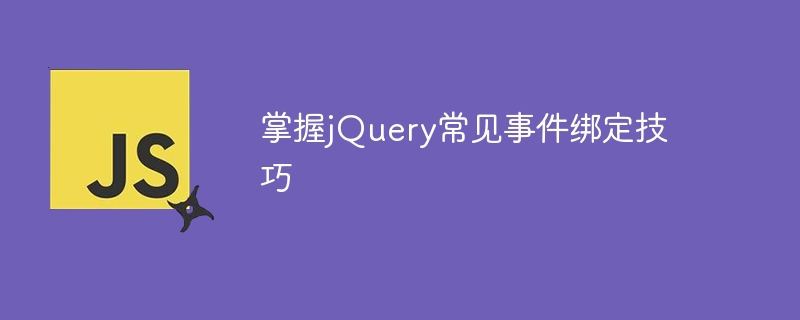Home >Web Front-end >JS Tutorial >Master jQuery common event binding techniques
Master jQuery common event binding techniques
- WBOYWBOYWBOYWBOYWBOYWBOYWBOYWBOYWBOYWBOYWBOYWBOYWBOriginal
- 2024-02-28 08:15:04782browse

jQuery is a widely used JavaScript library that makes front-end development more efficient and convenient by simplifying DOM operations and event handling. In the process of using jQuery for event binding, we need to master some common techniques to ensure code maintainability and performance optimization. This article will introduce some common jQuery event binding techniques and provide specific code examples for reference.
1. Use event delegation
Event delegation is a common optimization technique that can reduce the number of event handlers and improve performance. You can avoid binding events repeatedly on dynamically generated elements by binding the event to the parent element and then handling it based on the target element where the event occurred. Here is an example of using event delegation:
<!DOCTYPE html>
<html>
<head>
<title>事件委托示例</title>
</head>
<body>
<ul id="todo-list">
<li>任务1</li>
<li>任务2</li>
<li>任务3</li>
</ul>
<button id="add-btn">添加任务</button>
<script src="https://code.jquery.com/jquery-3.6.0.min.js"></script>
<script>
$('#todo-list').on('click', 'li', function() {
$(this).toggleClass('completed');
});
$('#add-btn').on('click', function() {
$('#todo-list').append('<li>新任务</li>');
});
</script>
</body>
</html>In the above example, dynamically generated can be achieved by binding the event to the #todo-list element. <li>Click event handling of elements.
2. Use event namespace
Event namespace can help us better manage events and avoid event conflicts and accidental unbundling. By adding a namespace to an event, you can trigger or unbundle events of the same type but different namespaces independently. Here is an example of using event namespaces:
<!DOCTYPE html>
<html>
<head>
<title>事件命名空间示例</title>
</head>
<body>
<button id="btn1">按钮1</button>
<button id="btn2">按钮2</button>
<script src="https://code.jquery.com/jquery-3.6.0.min.js"></script>
<script>
$('#btn1').on('click.test1', function() {
alert('点击按钮1');
});
$('#btn2').on('click.test2', function() {
alert('点击按钮2');
});
// 解绑test1命名空间下的事件
$('#btn1').off('click.test1');
</script>
</body>
</html> In the above example, we have added namespaces test1 and test2# for the click event ##, respectively corresponding to the click event processing of the two buttons.
once method to ensure that the event handler is executed only once, which is suitable for operations that only need to be executed once to avoid repeated execution and memory leaks. The following is an example of using the once method:
<!DOCTYPE html>
<html>
<head>
<title>once方法示例</title>
</head>
<body>
<button id="btn">点击一次</button>
<script src="https://code.jquery.com/jquery-3.6.0.min.js"></script>
<script>
$('#btn').once('click', function() {
alert('只执行一次');
});
</script>
</body>
</html>Through the above example, we can better master the skills of jQuery event binding, improve front-end development efficiency and optimize code quality. Hope the above content is helpful to you. The above is the detailed content of Master jQuery common event binding techniques. For more information, please follow other related articles on the PHP Chinese website!

